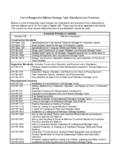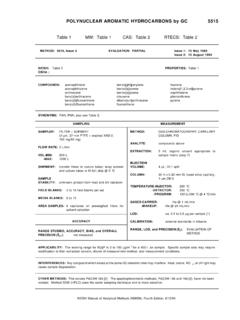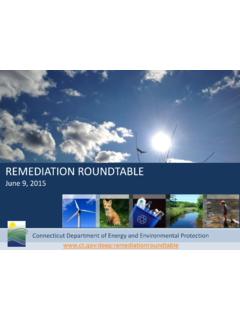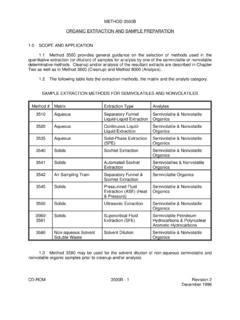Transcription of Reasonable Confidence Protocols - Connecticut
1 State Of Connecticut Department of Environmental Protection Recommended Reasonable Confidence Protocols Quality Assurance and Quality Control Requirements For Extractable petroleum Hydrocarbons by the State Of Connecticut , Department of Public Health ETPH Method Version July 2006 Written by the Connecticut DEP QA/QC Workgroup Revision Comments Date First version for publication 7/05 Final version based upon public comments July 2006 Connecticut DEP RCPs Quality Assurance and Quality Control Requirements Extractable petroleum Hydrocarbons, CTDPH, TPH Method Version July 2006 Table of Contents QA/QC Requirements for the CT-ETPH Method Reporting Limits for the CT-ETPH Table Typical Reporting General Quality Control Table IDOC Summary of the CT-ETPH Sample Extraction and GC Method Cross-contamination/ Quality Control Requirements for SW-846 the CT-ETPH General Quality Control Requirements for Determinative Chromatography Specific QA/QC Requirements and Performance Standards for SW-846 the CT-ETPH Site Specific Matrix Spike (MS), Matrix Spike Duplicate (MSD) Special Analytical Considerations for Table 1A Specific QA/QC Requirements and Performance Standards for the CT-ETPH Method*.
2 9 Additional Reporting Requirements for SW-846 the CT-ETPH Routine Reporting Deliverables for the CT-ETPH Reporting and Flagging of Table Report Table 2A Sample Containers, Preservation and Holding Page 2 of 15 Connecticut DEP RCPs Quality Assurance and Quality Control Requirements Extractable petroleum Hydrocarbons, CTDPH, TPH Method Version July 2006 QA/QC Requirements for the CT-ETPH Method Method Overview The CT-ETPH Method is gas chromatography procedure used to determine diesel range (C9 thru C36) petroleum hydrocarbons in soils, sediments and aqueous samples. This procedure requires an experienced GC analyst familiar with the QA/QC requirements of the method. The sample introduction procedure requires the use of a solvent extraction procedure. Open-tubular, capillary columns are employed with a flame ionization detector (FID). When compared to packed columns, these fused-silica, open-tubular columns offer improved resolution, better selectivity, increased sensitivity, and faster analysis.
3 Reporting Limits for the CT-ETPH Method The reporting limit (RL) for the ETPH is dependent on the concentration of the lowest standard in the initial calibration, sample weight/volume, extraction procedure, and moisture content. The following table lists approximate reporting limits for various matrices utilizing a gas chromatograph with a FID. Solid matrices in this table assume 100% solids. Table Typical Reporting Limits Matrix Typical Reporting Limit Water 100 ug/L Soil/sediment 100 mg/Kg Moisture content of soils and sediments will raise the RL, as all results must be reported on a dry weight basis for these two matrices. Sample dilution or lower sample weight/volume will also cause the RL s to be raised.
4 Sample container type, preservation requirements, and holding times for waters, soils, and sediments are presented in Table 2A of this document. Page 3 of 15 Connecticut DEP RCPs Quality Assurance and Quality Control Requirements Extractable petroleum Hydrocarbons, CTDPH, TPH Method Version July 2006 General Quality Control Requirements Each laboratory is required to operate a formal quality assurance program and be certified by the Connecticut Department of Public Health for the analysis performed. The minimum requirements include initial demonstration of laboratory proficiency, ongoing analysis of standards and blanks to confirm acceptable continuing performance, and analysis of laboratory control samples (LCS) to assess precision and accuracy. The use of site specific matrix spikes and matrix spike duplicates is highly recommended. Evaluation of sample matrix effects on compound recovery is key to making good decisions. Laboratories must document and have on file an Initial Demonstration of Proficiency for each combination of sample preparation and determinative method being used.
5 These data must meet or exceed the performance standards as presented in Section and Table 1A. See Section of Method 8000 in SW-846 for the procedure. The Initial Demonstration of Proficiency must include the following elements: Table IDOC Requirements QC Element Performance Criteria Initial Calibration Table 1A Continuing Calibration Table 1A Discrimination Check Table 1A Method Blanks Table 1A Average Recovery Table 1A % Relative Standard Deviation Table 1A Surrogate Recovery Table 1A Laboratories are required to generate laboratory specific performance criteria for LCS compound recovery limits, matrix spike/matrix spike duplicate compound recovery and precision (RPD) limits, and surrogate recovery limits. These limits must meet or exceed the limits specified in Table 1A. Page 4 of 15 Connecticut DEP RCPs Quality Assurance and Quality Control Requirements Extractable petroleum Hydrocarbons, CTDPH, TPH Method Version July 2006 Summary of the CT-ETPH Method Sample Extraction and Cleanup Samples for analysis by the CT-ETPH Method require extraction by one of the following methods.
6 SW-846 Method Matrix Description 3510C Aqueous Separatory Funnel liquid-Liquid Extraction 3520C Aqueous Continuous Liquid-Liquid Extraction 3511 Aqueous Organic Compounds in Water by Microextraction 3540C Soil/Sediment Soxhlet Extraction 3541 Soil/Sediment Automated Soxhlet Extraction 3545A Soil/Sediment Pressurized Fluid Extraction (PFE) 3546 Soil/Sediment Microwave Extraction 3570 Soil/Sediment Microscale Solvent Extraction (MSE) 3550C Soil/Sediment Ultrasonic Extraction GC Analysis The hydrocarbons are extracted from the sample using the appropriate procedure.
7 The solvent extract is treated with silica gel to remove any polar compounds. The silica gel is removed via filtration or centrifuging, followed by final concentration of the sample extract. Aliquots of the extract are injected onto the GC column in the gas chromatograph. The gas chromatograph (GC) oven is temperature programmed to facilitate separation of the analytes which are then detected by the FID. Identification of retention time window is accomplished by comparing the retention times of the chromatographic peaks of the standards. Confirmation is not required for this method. Quantitation is accomplished by integrating all peaks which elute in the retention time window. If the surrogate elutes in the retention time window, the area of the surrogate peak is subtracted from the total area for quantitation. Page 5 of 15 Connecticut DEP RCPs Quality Assurance and Quality Control Requirements Extractable petroleum Hydrocarbons, CTDPH, TPH Method Version July 2006 Method Interferences Refer to SW-846 Methods 3500 (Sec.)
8 , in particular), 3600, and 8000 for a detailed discussion of interferences. Interferences co-extracted from the samples will vary considerably from matrix to matrix. Dirty glassware, especially at ground glass joints, is the most common form of contamination leading to high method blank results. Analysts must ensure that all glassware is clean prior to sample processing. The flame ionization detector will respond to any compound which combusts in an air/hydrogen flame. As such many classes of compounds besides petroleum hydrocarbons will be included in the ETPH concentration. The use of silica gel to remove polar compounds ( fatty acids, tannins, etc.) is critical to the analysis. Samples highly contaminated may require additional silica gel treatments to remove these type compounds. Cross-contamination/ Carryover Cross-contamination can occur when any sample is analyzed immediately after a sample containing high concentrations of compounds which cause a detector response.
9 Syringes on the autosampler may also become contaminated in the same manner. If a high sample is inadvertently analyzed, the system must be demonstrated to be clean by analysis of solvent blanks. Laboratories should be aware that carryover from high boiling point compounds may not appear until a later run (ghost peaks). Quality Control Requirements for SW-846 the CT-ETPH Method General Quality Control Requirements for Determinative Chromatography Methods Refer to SW-846 Method 8000 for general quality control requirements for all chromatographic methods, and Section of the Connecticut ETPH method for specific QA/QC requirements. These requirements insure that each laboratory maintain a formal quality assurance program and records to document the quality of all chromatographic data. Quality Control procedures necessary to evaluate the GC system operation may be found in SW-846 Method 8000, Section , and include initial and continuing verification of instrument calibrations and chromatographic performance of sample analyses Page 6 of 15 Connecticut DEP RCPs Quality Assurance and Quality Control Requirements Extractable petroleum Hydrocarbons, CTDPH, TPH Method Version July 2006 Specific QA/QC Requirements and Performance Standards for SW-846 the CT-ETPH Method Specific QA/QC requirements and performance standards for SW-846 the CT-ETPH Method are presented in Table 1A.
10 Strict compliance with the QA/QC requirements and performance standards for this method, as well as satisfying other analytical and reporting requirements will provide the environmental professional (EP) with Reasonable Confidence regarding the usability of analytical data to support DEP decisions. While optional, parties electing to utilize these Protocols will be assured that agency reviewers will, generally accept Reasonable Confidence data. In order to achieve Reasonable Confidence parties must: 1. Comply with the applicable QC analytical requirements prescribed in Table 1A for this test procedure; 2. Evaluate and narrate, as necessary, compliance with performance standards prescribed in Table 1A for this test method; and 3. Adopt the reporting formats and elements specified in Section of this method. Site Specific Matrix Spike (MS), Matrix Spike Duplicate (MSD) Samples It is strongly recommended that site specific MS/MSD samples be analyzed from each site, and each matrix type sampled.















